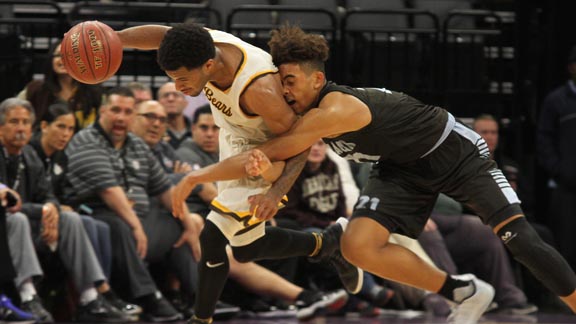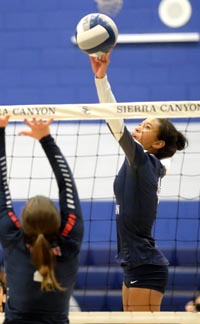
Niamey Harris from Mission of San Francisco (left) tries to fend off a steal attempt from Villa Park’s Myles Franklin during 2017 CIF Division III state championship. Under new competitive equity seeding, would Mission have even been in Division III last season? Photo: Willie Eashman.
We hope you enjoy this free post on CalHiSports.com. To join our Gold Club to get all new state rankings, state record updates and 2018 all-state team updates, CLICK HERE.
For those of you who have attended CIF state basketball championship games in Sacramento over the years, there have been outstanding teams in divisional finals lower than the Open Division, lower than Division I and even a few in Division IV and Division V.
James Harden (Artesia of Lakewood) and Klay Thompson (Santa Margarita) both played on boys teams that won Division III state championships. For the girls, Piedmont’s back-to-back Division IV state titles in 2004 and 2005 with the Paris twins (Courtney & Ashley) leading the way were both teams that were among the highest-ranked in the nation.

Jaylen Jordan and team at Sierra Canyon won CIF D2 state title. Looking at competitive equity seeding in volleyball shows how things might get done for upcoming CIF playoffs in basketball. Photo: SierraCanyonAthletics.com.
Even last year, Mission High’s historic run to the Division III boys state title that earned the city of San Francisco its first-ever public school state title and Eastside College Prep’s repeat in Division V girls showed off rosters from teams that arguably were top 25 overall in the state.
This season, though, anyone thinking that there will be teams in the Division III, Division IV and Division V brackets that will be close to even the top 100 in the state better start getting used to what’s going to happen with competitive equity seeding.
This new way of seeding teams into the Northern California and Southern California regional playoffs began in November for girls volleyball and if you use what happened in that sport as a barometer for how it may work in basketball, the results were less than stellar.
Competitive equity seeding is the process of putting teams into divisions with no regard whatsoever to enrollments or with section playoff alignments. Each section essentially ranks all of the teams that are qualifying for the regional playoffs based on competitive equity and then the CIF will base its regional divisions on those rankings.
A good example in volleyball is what happened for teams from the Marin County Athletic League in the CIF North Coast Section. League champ Marin Catholic went to the NorCal Open Division as expected, but Branson of Ross, a team that has won multiple Division V state titles, was placed into NorCal Division I. In that tougher bracket, Branson had no chance. A middle of the road MCAL team, San Marin of Novato, did get into NorCal Division V and then actually won the NorCal D5 title before losing in the state final.
Sure, the competition between the teams in the lower divisions of the new competitive equity based placements is fine. It’s just that in volleyball there clearly wasn’t a single team from Division III or lower that probably would be among the top 100 overall in the state. Possibly even top 200. Presentation of San Jose, which was battling for the cellar in the West Catholic Athletic League this season, won the D4 state title and still had a losing record.
For the Open Division in girls volleyball, competitive equity seeding made no difference for the goal of the top overall teams in the state playing each other. Archbishop Mitty of San Jose repeated with a 3-0 victory over Mater Dei of Santa Ana. The Monarchs also may be in the Open Division final in girls basketball this season like they were last season (lost to Clovis West) but probably will have to beat loaded St. Mary’s of Stockton a second time in the NorCal final.
The D1 bracket in girls volleyball also featured a lot of other strong teams, but with the same problem that basketball has had in recent years and that’s that the fifth or sixth-best overall teams from the CIF Southern Section that don’t get into the SoCal Open Division are teams that have tended to be a lot better than other non-Open Division teams from the rest of the state. Remember, just like in volleyball continued to be this season and in the past, there will continue to be a limit of four teams from any one section that can be in the Open Division.
Once you started getting into D2, however, some of the weaker state volleyball teams began to emerge and then in D3 and lower there wasn’t even a State Top 20 bubble team close to be found. The CIF will point out that this new method will provide experiences for some of these schools and student-athletes that they would never get before. That’s true, it’s just that the teams themselves actually aren’t that good and certainly aren’t close to being as strong as those teams many of us have gotten used to watching in some of the lower divisions.
The CIF football games in the last three years have been determined by the same competitive equity factors. It’s just that in football we’re only dealing with section championship teams (with a few runner-up exceptions). When this system gets extended into 16-team Open Divisions and more 32-team brackets, there’s just not enough qualified, strong teams to fill them out. The deeper you go, the weaker the teams get.
We’ll still heartily attend and support the CIF state basketball championships this March. The Open Division, Division I and hopefully Division II finals will be worth watching. Based on what happened in volleyball, however, the opportunities to take breaks during the other games will be much more frequent.
Mark Tennis is the co-founder and publisher of CalHiSports.com. He can be reached at markjtennis@gmail.com. Don’t forget to follow Mark on the Cal-Hi Sports Twitter handle:





13 Comments
Mark,
Have been wondering about this issue for a while now. Do you know if teams in the SS will be placed into their respective divisions this year like last year, if they are not selected for the Open? Due to the enormous size of the SS , there were strong teams placed in D1 and D2 last year. The same thing could happen this year. Once you select only four teams for the Open, there are a bunch of really good teams left over for the other divisions.This year, Rancho Christian and Los Altos are in the SS D2 and St. Anthony is in D3. Below that, it gets kind of weak. I think that the north more than the south is at a disadvantage due to the competitive equity process.
I would expect Rancho Christian is going to be D1 for boys bb and not D2 (which is its CIFSS division) if it doesn’t make the CIFSS Open Division semifinals. St. Anthony might actually be up in D1 as well. And when it’s depth of teams across the board, then the north will always be at a big disadvantage with competitive equity seedings and pairings. Using the volleyball playoffs as a guide, the only NorCal team to win other than Mitty in the Open was Presentation (from the same league) in D4. Still trying to figure out how Presentation got all the way down into D4, but something similar may be how a NorCal basketball team can overcome the depth problem with competitive equity seeding.
I understand your sentiments.
However doing it by school size wasn’t perfect either. For example those lower division powerhouses were romping to titles and maybe facing an equal at the end. If that public school had 1000 kids and a similar private school had the same amount of students. The majority of the time that private school had an advantage. Those private school kids may skip anywhere from 2 to 100 schools to attend that certain private school. So what you had was an unbalance. I believe if I am correct that Mater Dei at 2000+ kids wouldn’t be at the largest school size level in the state. As there are many 2500-3500+ student sized schools in the state. But they know that playing for that lower division title isn’t as prestigious or realistic. How would Mater Dei look like if all their sports teams were stocked with kids from Santa Ana? Honestly tell the truth. I’m not even going to begin to mention recruiting which has gone on from at least the 80’s. The same thing with Bosco with around 900 kids. Do you honestly think a similar sized high school would be a football power stocked with kids strictly from Bellflower? If they played in a lower division, what do you think the results would be? Some might bring up Long Beach Poly and the open district advantage they have. Well that’s why back in the 90s certain coaches nicknamed them St. Poly. Sidenote have you noticed the downfall of Poly coincides with the rise of Bosco as a football superpower? Bellflower is close to Long Beach. If football separated by population what would Bosco do to most similar sized schools? I am sure there are some in Northern California who would like to see DeLaSalle play Folsom for the right to play in the open division state title game in football. Just threw that out there lol. Competitive equity should be an evening out of the process. Some schools have romped to state titles in lower divisions for years. Well now they earn that high state rating by playing similarly talented schools. Yes some public schools will have to pay the price. But this is the best way to do this other than what a lot of states do by separating Private and Public schools for state championships.
Yes I know I wouldn’t mention recruiting but I am interested in your take about IMG academy coming into California and openly recruiting talent? I mention this because schools are upset including private schools. Which is kind of hypocritical because certain local private schools have grabbed kids from other schools for years. For example a certain safety from the I.E. playing all state caliber football at Bosco. Or next season 2 big time national top 150 talents are going from the Inland Empire to Mater Dei. Did I mention the 2020 highly rated QB that will magically start next season at Mater Dei from Cathedral high school? IMG is poaching kids from public and private schools and having them suit up in Florida. A story about IMG encroaching in on California state talent as well as other states would be interesting. Also what the state commissioners think about it.
I don’t think it should be enrollment-based, either, but prefer the CIF Sac-Joaquin Section system which more slowly moves up teams that are dominating in playoff divisions. The SJS doesn’t have much of a process for moving down large-enrollment schools that struggle, though, so it’s not perfect, either. I’ve been to every CIF state basketball championship (only missed one day since event began in 1979) and am just having trouble envisioning the teams we’ll see in the lower divisions starting this year. The CIF wants to trot out mediocrity to celebrate and give kids a great experience. I get that. I’m just not excited about watching all of these weaker teams.
As for your question about IMG, I wouldn’t have a problem with it if IMG wasn’t also trying to “win” national ranking titles over “regular” high schools. If it’s a player development issue, like a kid going to Prolific Prep in Napa for basketball, it makes complete sense for an elite player to go there. The clock is ticking on these kids’ ability to develop as players and possibly get to the pros. The CIF and other state associations could hurt the IMG model if they banned their schools from playing them.
Mater Dei, Bosco and Bishop Gorman have all obviously gone to an IMG light sort of model where they are all now getting players from basically everywhere. Nobody else now can really compete. De La Salle has never gone to the transfer model like the other two and now it seems they can’t even compete anymore. Can Centennial stay close? Doubt it. Can Folsom perhaps next season? Possibly but probably not, either. I actually hope IMG does raid Bosco and Mater Dei for more of its players and I know IMG got one Bosco guy already. The only good thing is that Bosco and Mater Dei are in this arms race so to speak against each other. At least it’s not just one school getting superstar transfers and slaughtering everyone in its path. And at least there are a vast majority of schools in the state that don’t have to worry about ever playing those two super-sized transfer schools. They can just play in the open division. That’s not good for the other CIFSS D1 schools that now have now chance (example Mission Viejo) but at least for many, many schools the path toward winning a state title doesn’t involve Bosco and Mater Dei.
Mark–
It would be more fair for Saint Bernard’s of Eureka to be required to play De La Salle in a playoff game–in any sport–than for any public school to be required to play either Saint Bernard’s or De La Salle in a playoff game. In my opinion, the first step is separate playoff divisions for public schools and private schools. The we could start to discuss whether how enrollment affects competitive equity.
Two years ago, instead of using my NCS lifetime pass to attend NCS playoff games involving private schools, my son and I traveled to Fresno for the Saturday championship games in the Central Section basketball playoffs. Last year
I drove to Stockton for the Friday Sac-Joaquin championship games. The atmosphere at both places was far more relaxed than what I find for a De La Salle game at Saint Mary’s College.
John Zugnoni, Alameda
Mark, Have often wondered if De La Salle players come exclusively from Concord, or do they draw players from the Bay area in general?
I know Aaron Taylor moved there from Marin County but almost all of their players are from the Pittsburg-Antioch-Concord-Danville-Pleasanton area. The late Terrance Kelly was from Richmond and maybe a few from Pinole. They’ve never had senior transfers and have never had an influx of transfers like MD and Bosco are now getting. It’s a whole new ballgame the way they’re doing it now.
Thanks. The way that DLS has been dominated last two years, it is obvious that something drastic has been going on. I think Centennial is mostly local or nearby kids, but not the transfers like Bosco and MD. They have been able to give DLS games in recent years. Sondheimer has been harping on the transfers a lot, and I think justifiably so. They need to go back to the old rule of having players sit out one year. I think this would slow it down.
Mark, Phil 60, and Louis;
Mark, you have really opened up a situation that really needs to be addressed and solved if high school sports in California are going to survive in some kind of “healthy” way. Is there any state that has a more discombobulated playoff system than California? I know of nowhere else where there are a number of basically autonomous sections that vary a great deal in size, criteria for determining playoff divisions, the number of playoff rounds, and in the enforcement of transfer and eligibility rules.
My two bits worth is that the State Legislature needs to completely re-organize CIF into 8 new sections that are comparable in size, uniform in playoff division criteria, as well as enforcement of transfer and eligibilty rules. I do realize that some division criteria allowances would need to be made between NorCal and SoCal since roughly 60% of LACS and SS, and 55% of SDS public high schools have enrollments over 2000, with CCS, CS, NCS, and SJS having only about 20% each. About 60% of NS are under 500, and according to the last CBEDS I read, has no high school over 2000. I would think there could be 4 sections south of the Tehachapis; 1 section straddling them and including Ventura, Santa Barbara, SLO, and Kern counties; and 3 sections north of Kern and SLO counties.
When it comes to transfers, it could be quite simple: a student may transfer once for any reason without sitting out, provided the school’s policy to where he or she is transferring accepts transfers on a “1st come, 1st serve” equal basis and doesn’t favor outstanding athletes, math geniuses, or gifted tuba players, or the like. Schools that violate this would not forfeit games but would not be eligible for playoffs that season or the next in that sport. The student must make the transfer before the semester starts (This includes before summer full practice and scrimmages.). Otherwise the student sits out the season. Rules and criteria for hardship situations for multiple transfers should be established, but the burden of proof is on the student-athlete and parent/guardian which would require legal documents, not merely a rental deposit receipt or the like. In so-called family separation “hardships”, I would like to see a requirement of a bond have to be put up by the family, which would be forfeited should there be “questionable behavior” by the family after the student leaves high school. No bond: the student-athlete sits out. The school being transferred to would be required to stay out of it. If school interference can be shown, than the playoff ineligibility would apply.
As for division placement of teams, I would use a single criterion: “the old bottom line”: MOOLHA; DINERO; BUCKS! The more that a team is budgeted, the higher the division it’s in (This would include the grant in aid money athletes on that team receive.). Also, there should be a limit as to how many coaches (paid or otherwise) a team can have in a particular division.
Comments welcome.
Thanks, Tim. In the past, we’ve suggested a large NorCal section and a large SoCal section with four sub-sections in each. Don’t know if the legislature could do much and I don’t think this is an issue that is important enough to do something like put a proposition on the ballot. As the super private-school programs continue to develop and continue to go the multi-transfer route to dominate, the public schools more and more will be pushing to be split from the private schools. I’ve never been for that and the CIF is going with this competitive equity playoff system so that the large public high schools in general don’t have to compete with the super private schools unless you’re one of those CIFSS D1 schools like Mission Viejo, Rancho Cucamonga, etc. Put those schools in the Open Division and then the rest of the schools don’t have to bother with them.
Thanks for CIF Regional and State playoff changes. With the State changing to using rankings to put teams into different divisions instead of enrollment does the qualification to get into the State playoffs go by rankings too?? If a top team gets upset in its Section playoffs but there ranking remains high will the team still qualify for State?
Thanks again!!
No, the qualifications to get into the state basketball playoffs based on making the semifinals, etc. from section playoffs still applies. They aren’t going to be pulling up any teams that get upset in the early rounds of a section playoffs.
I don’t think it should be all or nothing . school size may not be THE determining factor, but the truth of the matter is that if you have 1000 freshman enter your school, you can dramatically turn around a program with just a couple players. in a HS with 100 kids total, if they have a good year one year, or play in a tournament where they play better division teams, then they get moved up to a division and never have a chance in playoffs for a couple years! school size should be considered for the very small schools especially. It is broken now because rankings/performance should be a factor, but school size should be as well especially for the extremes. 3500 kids vs 90 kids in a HS.